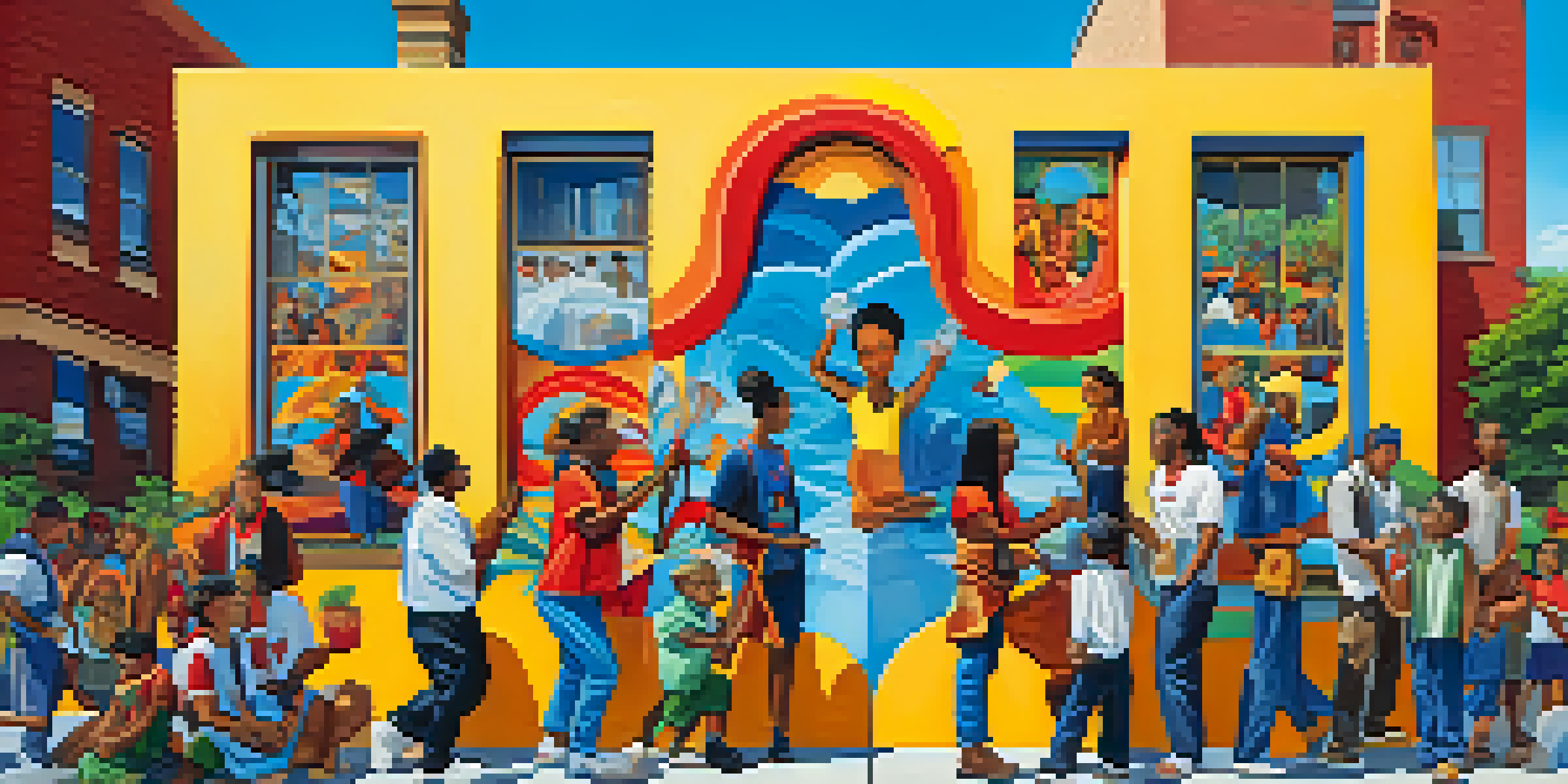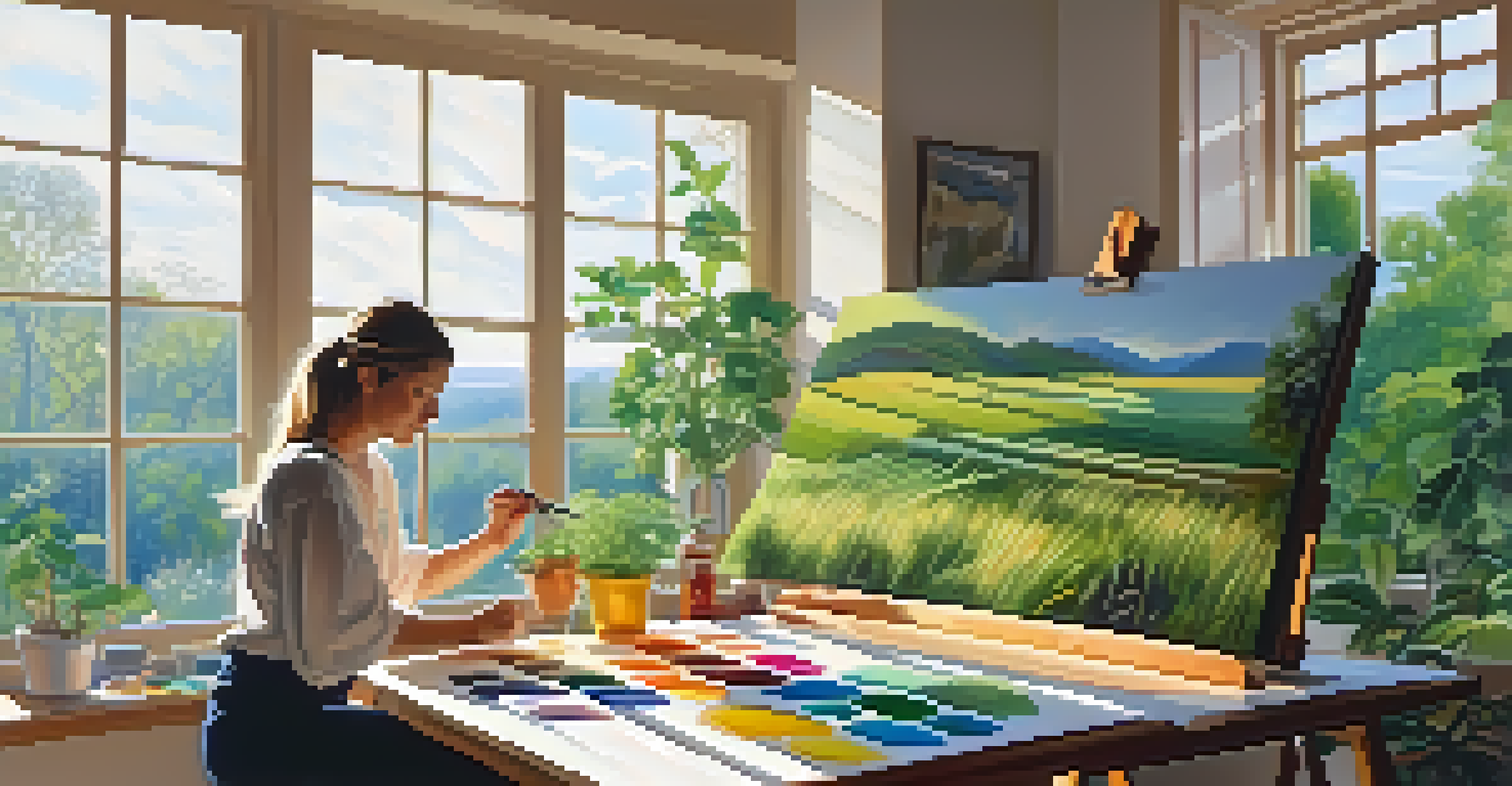Cross-Disciplinary Collaborations Shaping Future Painting

The Rise of Cross-Disciplinary Artistry
In today's art world, collaboration across disciplines is becoming increasingly popular. Artists are merging traditional painting techniques with insights from fields like science, technology, and even psychology. This fusion not only broadens the scope of artistic expression but also invites audiences to experience art in novel ways.
Art is not a mirror held up to reality, but a hammer with which to shape it.
For instance, painters are now using data visualization to interpret complex information visually. By incorporating elements from data science, artists can create pieces that tell stories through numbers and patterns, engaging viewers on multiple levels. This approach not only makes art more relevant but also sparks conversations about the issues represented.
Moreover, collaborations with scientists have led to innovative materials and techniques in painting. Artists are experimenting with bio-based paints or utilizing augmented reality to enhance their work, creating immersive experiences that challenge the traditional boundaries of what painting can be.
Technology's Impact on Modern Painting
Technology is reshaping the landscape of painting in remarkable ways, blending the digital with the physical. Digital painting platforms allow artists to experiment without the constraints of physical materials, which encourages spontaneity and exploration. This flexibility can lead to unexpected creative breakthroughs.

Additionally, the rise of social media has transformed how artists share their work. Platforms like Instagram serve as virtual galleries, enabling artists to reach global audiences instantly. This exposure can lead to collaborations with other creatives and even industries, pushing the boundaries of modern painting.
Art Merges with Science and Tech
Artists are increasingly collaborating with scientists and technologists, leading to innovative techniques and materials that enhance artistic expression.
Furthermore, artists are leveraging technology to incorporate interactive elements into their work. By using sensors or projections, paintings can respond to viewer movements or sounds, making the experience dynamic and engaging. This interactivity invites audiences to become part of the artwork, redefining the relationship between the viewer and the painted piece.
Art and Environmental Awareness
As awareness of climate change grows, many artists are turning to environmental themes in their work. Collaborations with environmental scientists and activists have led to paintings that not only depict nature but also comment on its fragility. These pieces often serve as calls to action, urging viewers to reflect on their relationship with the environment.
Creativity takes courage.
For example, some artists are using recycled materials in their paintings, creating stunning visuals while promoting sustainability. This approach not only reduces waste but also highlights the importance of resourcefulness in art. By merging environmental consciousness with artistic practice, these collaborations are paving the way for a more sustainable future in the art world.
Such initiatives often inspire community engagement, as local artists partner with environmental organizations. Public art projects can transform urban spaces, making statements about nature and conservation that resonate with wider audiences. This blend of art and activism fosters a collective movement towards more sustainable practices.
Cultural Exchange and Global Perspectives
Cross-disciplinary collaborations often bring together artists from different cultural backgrounds, enriching the painting landscape with diverse perspectives. This cultural exchange fosters creativity and innovation, leading to artworks that reflect a multitude of experiences and stories. As artists collaborate beyond borders, they create dialogues that resonate on a global scale.
For instance, projects that pair local artists with international collaborators can result in unique fusion styles that blend techniques and themes from various cultures. These collaborations encourage mutual understanding and respect, enhancing the richness of the artwork. Viewers are invited to explore new narratives that challenge their perceptions and broaden their horizons.
Art as a Catalyst for Change
Cross-disciplinary collaborations empower artists to tackle social issues, using their work as a platform for advocacy and community engagement.
Moreover, exhibitions showcasing cross-cultural collaborations highlight the importance of diversity in art. They showcase how different cultural elements can enhance a painting's depth and meaning, ultimately leading to a more inclusive art world. This celebration of diversity not only enriches the art itself but also fosters a sense of community among artists and audiences alike.
Educational Collaborations Shaping Future Artists
Educational institutions are increasingly fostering cross-disciplinary collaborations as a way to prepare future artists. By integrating art programs with fields like science, technology, and social studies, schools encourage students to think creatively and critically about their work. This holistic approach nurtures well-rounded artists who can navigate various challenges in their careers.
Workshops and residencies that bring together artists and professionals from other disciplines allow for hands-on learning and experimentation. For example, an artist might collaborate with a scientist to explore the chemistry of pigments, leading to innovative painting techniques. Such experiences not only enhance artistic skills but also inspire a deeper understanding of the world around us.
Furthermore, these educational collaborations often culminate in public projects that engage the community. Students and professionals come together to create murals or installations that reflect local issues, fostering connections between art and social responsibility. This involvement in community art initiatives ensures that the next generation of artists is both skilled and socially aware.
Art as a Medium for Social Change
Art has long been a powerful tool for social change, and cross-disciplinary collaborations amplify this potential. By combining the insights of artists with activists, social scientists, and community leaders, paintings can address pressing social issues. These collaborations often lead to artworks that challenge societal norms and inspire action.
For instance, murals created through community collaboration can depict local histories and struggles, fostering a sense of identity and empowerment. Such art serves not only as a visual statement but also as a rallying point for community advocacy. This blend of art and activism highlights the role of painting in driving social movements.
Global Perspectives Enrich Art
Cultural exchanges among artists foster diverse narratives and styles, creating artworks that resonate with broader audiences and challenge perceptions.
Additionally, partnerships with organizations focused on social justice allow artists to amplify marginalized voices. Through collaborative projects, artists can create pieces that bring attention to issues like inequality and discrimination, encouraging dialogue and reflection. This important work contributes to a more equitable society, proving that art can be a catalyst for change.
The Future of Painting: A Collaborative Vision
As we look to the future, it's clear that cross-disciplinary collaborations will continue to shape the evolution of painting. The melding of diverse perspectives and expertise fosters an environment ripe for innovation and creativity. Artists are not just painters; they are thinkers, problem solvers, and changemakers who draw inspiration from the world around them.
By embracing collaborations with other fields, artists can address contemporary challenges while expanding their creative toolkit. This openness to experimentation and learning will lead to groundbreaking works that resonate deeply with audiences. As the lines between disciplines blur, we can expect to see painting evolve in ways we can only begin to imagine.

Ultimately, the future of painting lies in its ability to adapt and respond to the ever-changing landscape of society. As artists continue to collaborate across boundaries, they will create works that not only reflect the times but also inspire hope and resilience in a rapidly shifting world.